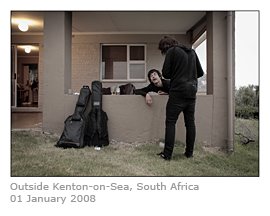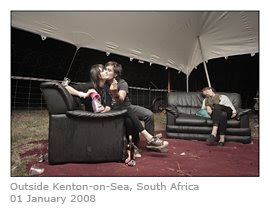 I have blogged this image before, in reference to Caravaggio... it immediately stood out for me, that second it was taken. I was with friends, New Year's Eve/Day, outside Kenton-on-Sea after a concert, and the night had gone pear-shaped, as would most of the day to follow. I think we were stranded...
I have blogged this image before, in reference to Caravaggio... it immediately stood out for me, that second it was taken. I was with friends, New Year's Eve/Day, outside Kenton-on-Sea after a concert, and the night had gone pear-shaped, as would most of the day to follow. I think we were stranded...I was down there with Zander, and we had been discussing what "painterly" should mean in connection to photography. This image, based on biographies I had been reading, made some sense to me, in light of this written of Caravaggio:
... the characteristic look of the work of Caravaggio — night-time setting, dramatic lighting, ordinary people used as models, honest description from nature.
Even words he wrote of himself:
All works, no matter what or by whom painted, are nothing but bagatelles and childish trifles... unless they are made and painted from life, and there can be nothing... better than to follow nature.
Somewhere along the line Zander had loaned me John Gash's biography on the artist, but with work piling on in the new year, and moving house and the like, it took me until August to find it again. When I did locate it, I turned to Death of the Virgin at random in an attempt to explain why I called the photo above "the Caravaggio."
This painting had not stood out for me any more than the others, though I was aware of the history and controversy surrounding it, its one particular connection top Carravagio's practice of using those around him as models, particularly a courtesan for the Virgin (though the true nature of the debate seemed more a dogmatic one, according to Gash).
 I had sat for hours on Zander's couch, as he worked on The Drain of Progress, reading through his collection of art books and biographies... some of it seemed to leak through, it seemed, along with other phrases and snatches of ideas from other sources... guidelines...
I had sat for hours on Zander's couch, as he worked on The Drain of Progress, reading through his collection of art books and biographies... some of it seemed to leak through, it seemed, along with other phrases and snatches of ideas from other sources... guidelines..."radical naturalism which combined close physical observation with a dramatic, even theatrical approach to chiaroscuro..."
"the painting recalls The Entombment in scope, sobriety and the photographic naturalism..."
His dismissal of lengthy preparation or working from sketches, preferring the Venetian process of working directly in oils from the subject, something he was denounced for, as it was perceived a failing!
"... figures in vast areas of darkness; they suggest the desperate fears and the frailty of man, and at the same time convey with a new and desolate tenderness the beauty of humility and the meek, who shall inherit the earth."
"... to express in one scene of unsurpassed vividness the passing of a crucial moment."
"Innovations inspired the baroque, but took the drama of his chiaroscuro without the psychological realism."
More to follow...








5 comments:
A convergence of convergences?
also here and here.
Thanks for the link M... it's funny, but halfway down the page there is a reference to a Goya work, connected to Bush and the Pope...
That particular Goya, "Saturn Devouring His Son", will also feature in this blog... though sans infant, as a reference by an artist to a photograph I took of him...
Still to come.
Incidentally, do you think I should enter some of the images that'll appear on this blog into "A convergence of convergences"?
Yeah, definitely.
(The Goya 'convergence' is hilarious/terrifying. Probably my favourite.)
Post a Comment